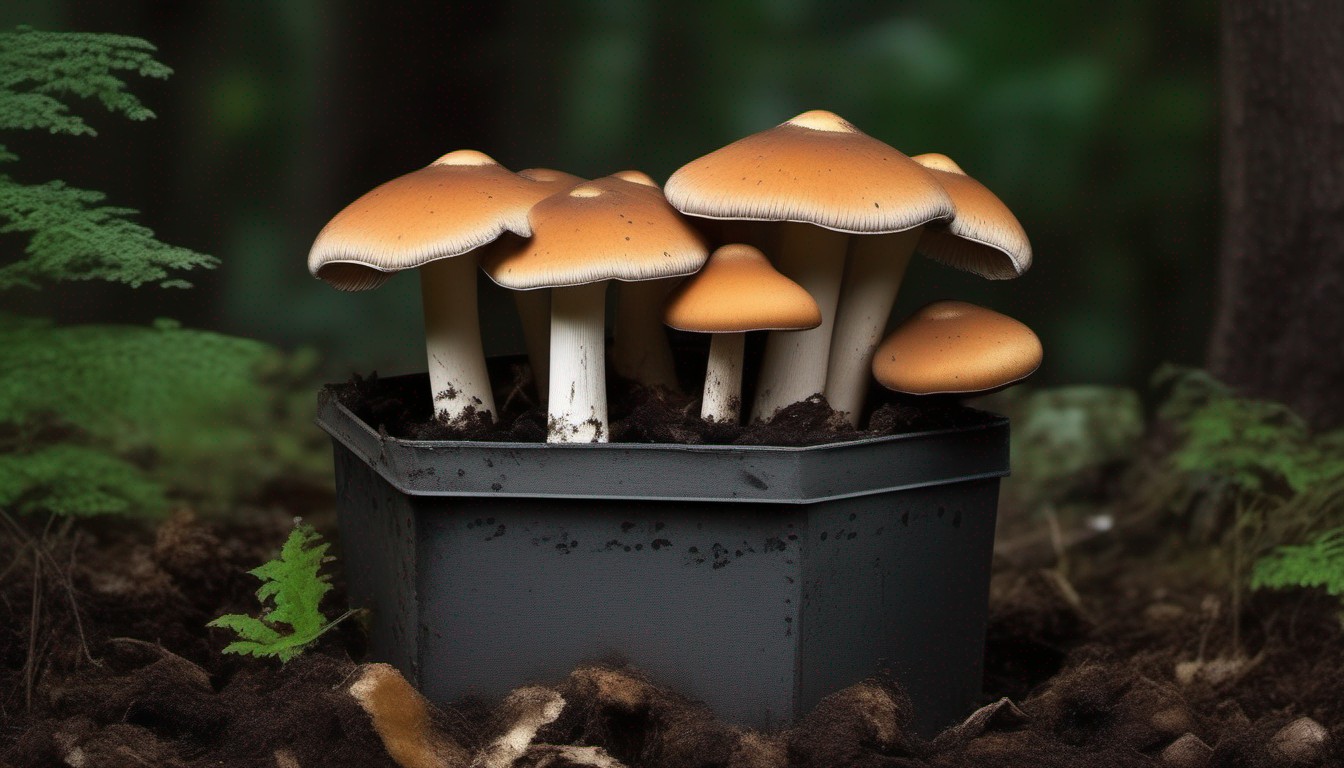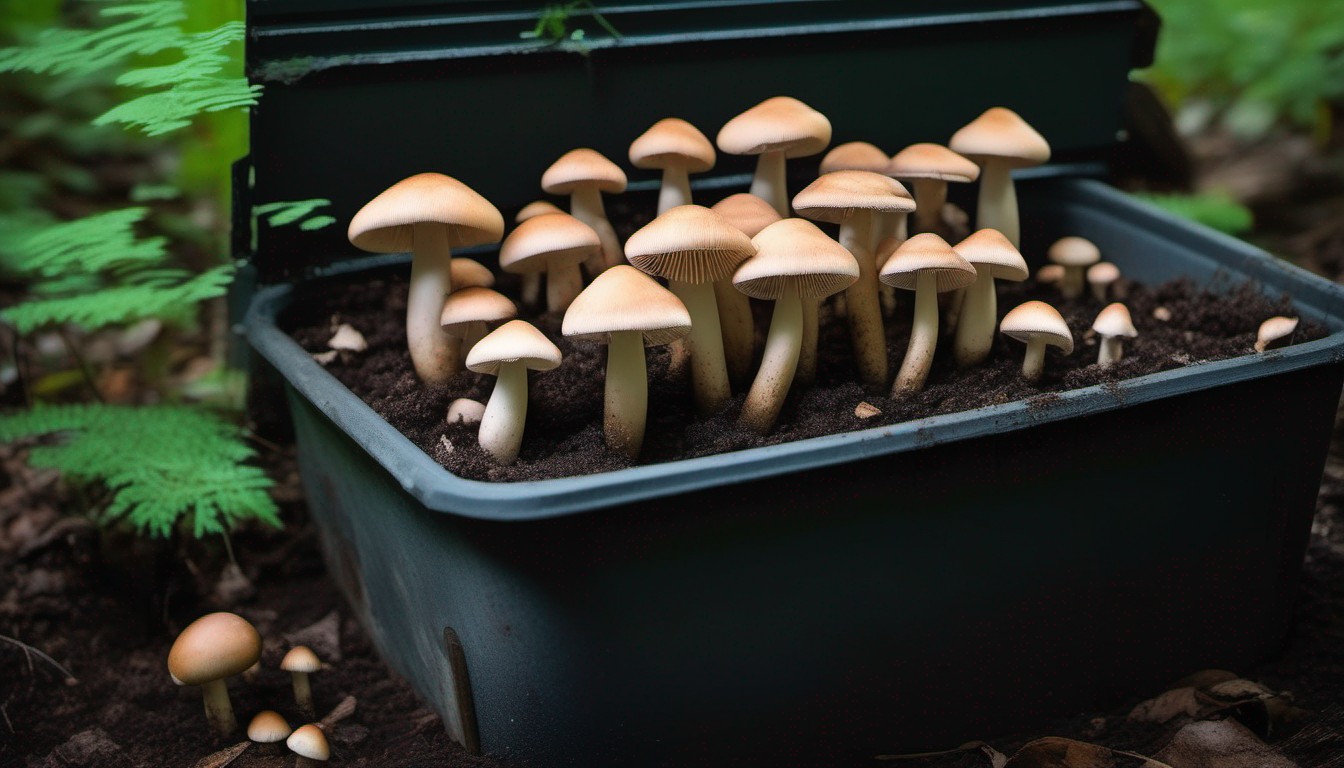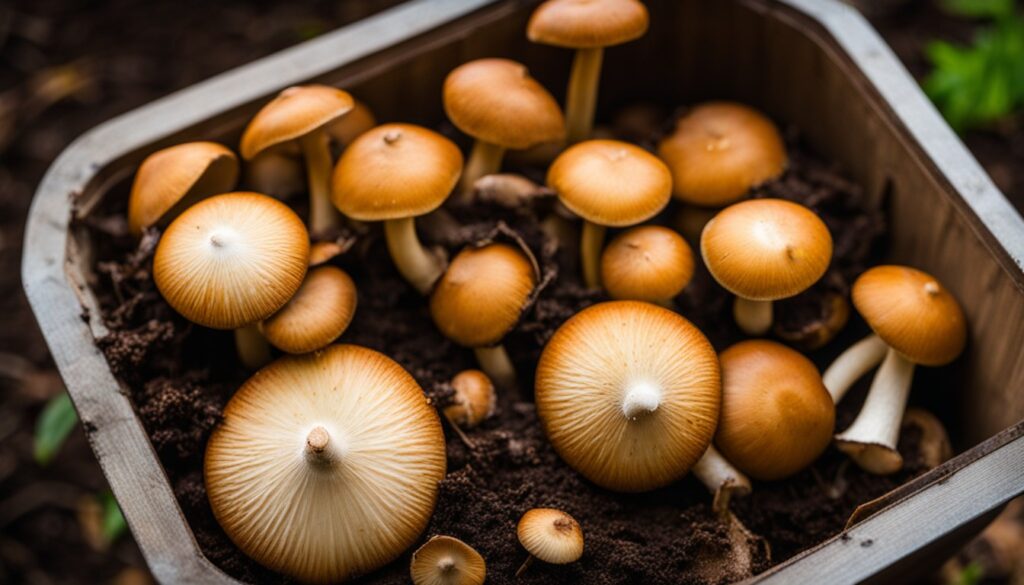Mushrooms in a compost bin can be both fascinating and beneficial for your garden. Understanding the role of fungi in the composting process and learning how to identify different types of mushrooms can enhance your gardening experience. In this comprehensive guide, we will explore the connection between mushrooms and compost bins, providing valuable insights and practical tips for incorporating fungi into your garden ecosystem. With our expert advice, you can harness the power of mushrooms to create nutrient-rich compost and promote a thriving, sustainable garden.
Understanding Fungi
Fungi, represented by mushrooms, yeasts, and molds, are a diverse group of eukaryotic microorganisms. While they often go unnoticed, they play a pivotal role in ecosystems by decomposing dead organic material and releasing essential nutrients back into the soil.
A crucial role of fungi in our environment is to break down complex organic materials into simpler compounds, enriching the soil and supporting nutrient cycles.
The critical role of fungi in soil involves transforming hard-to-digest organic material into forms that other organisms can utilize. In the web of life, fungi are decomposers turning complex organic materials into simpler compounds, thus playing a vital role in nutrient cycling.
What are fungi?
Fungi, in the realm of mycology, bear a distinctive non-plant classification. They encompass diverse organisms such as molds, yeasts, and, not least of all, mushrooms.
These organisms originate from microscopic spores. Unseen to the naked eye, these ‘seeds’ open a gateway to the fascinating world of fungi.
Unlike plants, fungi lack chlorophyll, allowing them to survive in myriad environments. As decomposers, they break down organic material, releasing valuable nutrients to the soil beneath.
In the compost bin, fungi are instrumental. They accelerate decomposition and contribute to nutrient cycling, establishing the foundation for a thriving garden.
With about 120,000 known species, fungi showcase immense diversity. Recognizing them paves the way for safely harvesting edible mushrooms or tackling potentially harmful ones in your compost bin.
The role of fungi in composting
Fungi play an integral role in decomposing organic matter present in compost. They break down complex cellulose and lignin structures, leading to humus formation which is crucial for healthy soil.
Instead of considering fungi as intruders in your compost bin, recognize them as industrious helpers. They catalyze the decomposition process, turning waste into nutrient-rich soil amendments faster.
Their relentless effort in breaking down tougher materials adds value to garden composting. An understanding of their contribution can enhance one’s gardening practices, with the compost’s efficiency increased manifold.
Moreover, their capacity to decompose organic wastes that are typically more challenging for bacteria, further posits fungi as a key contributor in composting. A fungal-infused compost pile holds great potential, from enriching soil fertility to revitalizing a garden’s overall health.
Types of Mushroom in Your Compost Bin
Beneath the organic patchwork in your compost bin, a colorful cast of mushrooms can surface, ranging from agarics to zygomycetes. Understanding these organisms’ unique characteristics helps in successfully handling your compost ecosystem.
Your compost bin is a veritable treasure trove of diverse mushroom varieties, each contributing differently to the decay process. Recognizing their individual traits facilitates efficient composting and offers insights into soil fertility enhancement.
Common mushroom species
In compost bins, a diverse community of fungal species thrive, contributing to the decomposition process and nutrient cycling. Certain mushroom species are more common than others, playing key roles in this ecosystem. Explore these familiar faces next time you peek into your bin.
- Agaricus bisporus: Known for its culinary uses, typically found in mature or ‘finished’ compost.
- Coprinus comatus: Also called Shaggy Ink Cap, it’s common in rich, fertile soils and compost heaps.
- Psilocybe cubensis: A tropical species often found in manure-based composts, though not safe for consumption.
- Stropharia rugosoannulata: Dubbed as ‘Garden Giant’, prefers wood-rich compost and is edible when young.
- Leucocoprinus birnbaumii: Also known as the Yellow Houseplant Mushroom, it thrives in indoor potted plants with rich organic material.
Edible mushrooms in compost
Edible mushrooms can flourish in your compost, providing an unanticipated source of culinary ingredients. However, it’s important to have knowledge of which are safe to eat, as misidentification can potentially lead to toxicity.
- Cultivating Culinary Delights: Mushroom species Shaggy Mane, Wine Cap, and White Button can all be grown in compost heaps provided the right conditions are met.
- A Myco-Gourmet’s Guide: Oyster mushrooms, King Stropharia, and Shaggy Parasol are wonderful examples of compost-friendly fungi that are not only edible but exquisitely tasty as well.
Toxic and harmful mushrooms
Although compost bins often attract beneficial fungi, caution must be exercised as toxic and harmful mushroom species can sometimes show up. Understanding the risks and being able to identify these potentially noxious varieties helps in maintaining a safer composting environment.
- Amanita phalloides (Death Cap) – highly toxic and can be fatal if consumed.
- Galerina marginata (Deadly Galerina) – contains harmful toxins similar to those in Death Cap.
- Clitocybe dealbata (Ivory Funnel) – poisonous mushroom that can cause serious gastrointestinal distress.
- Podostroma Cornu-Damae – rare, but deadly with toxic effects impacting multiple organs.
Benefits of Mushrooms in Compost

Composting efficiency sees dramatic improvements with mushrooms, providing a proficient decomposition of organic matter hence quickening the composting process. Their beneficial network of mycelium acts as nature’s recycling agents, breaking down complex organic compounds and enhancing nutrient availability.
Embracing mushrooms in your compost leads to pristine gardening performance. These fungi can increase soil fertility, suppress garden pests, and promote biodiversity. By enhancing the garden’s ecosystem, mushrooms contribute towards cultivating healthier, more robust plants.
Improving soil fertility
Mushrooms play a significant part in augmenting soil fertility. They decompose organic waste and transform it into a nutrient-rich substrate, providing essential nutrients for plant health and growth.
- Facilitating nutrient cycling and promoting enhanced nutrient availability.
- Helping in the transformation and breakdown of organic waste into a rich substrate.
- Promoting the growth and strength of various plants by providing essential minerals and nutrients.
- Aiding in the creation of a healthy, productive garden environment by balancing soil pH.
Breaking down organic matter
Mushrooms act as a potent catalyst for decomposition, converting the organic waste in your compost bin into a nutrient-rich loam. They have the unique ability to break down complex organic material, facilitating the conversion process from waste to wealth.
- Mushrooms break down hard fibrous material such as wood and straw.
- Fungi create enzymes that help decompose complex organic substances.
- Mushroom-induced composting helps recycle nutrients in the soil.
- The unique fibrous network of mushrooms helps distribute nutrients evenly throughout the compost.
Providing natural pest control
Mushrooms serve as natural pesticides, warding off harmful garden pests. They produce substances that act as repellents, disrupting the life cycle of various pests and hindering their proliferation.
Strengthening your garden’s defense with the incorporation of mushrooms has proven quite effective. Fungi-based pest control methods not only deter insects but also reduce the risk of plant diseases.
The unique biochemical interplay between mushrooms and pests works in favor of your farm. Using such naturally derived pest deterrents is a nod towards sustainable and responsible gardening practices.
Harness the power of mushrooms in your garden for its inherent pest control capabilities. It’s an environmentally friendly route that contributes to garden health while maintaining the fragile balance in your garden’s ecosystem.
Enhancing biodiversity in your garden
Enhancing biotic diversity in your garden, mushrooms serve as organic powerhouses fostering a lively habitat for beneficial insects, microorganisms, and native plants. They cultivate an enriching environment that supports a diversified ecosystem, ultimately contributing to garden vitality.
Mushrooms play an instrumental role as biological boosters. They encourage an increase in species richness by breaking down complex organic matter into simpler forms, providing nourishment for other organisms, and creating a conducive environment for the proliferation of diverse life forms, enriching the overall biodiversity of your garden.
Managing Mushroom Growth in Your Compost Bin

Taking charge of mycelium development in your compost bin is crucial, which involves understanding the mushrooms’ lifecycle and curtailing their growth when necessary.
To maintain a balanced mushroom population in compost, regulate environmental factors such as humidity and temperature, and maintain a proper carbon to nitrogen ratio in the compost mix.
Creating the right environmental conditions
Essential to mushroom growth in your compost bin, the creation of ideal conditions stimulates composting fungi. A mix of suitable temperature, humidity, and oxygen levels will encourage a healthy fungal population.
To establish a beneficial mycological environment, you must pay special attention to the compost bin’s conditions. Success largely hinges on your ability to replicate natural habitats that fungi thrive in.
Fungi thrive in damp conditions. Hence, moisture management plays a significant role in creating the right environment. However, do ensure your compost bin doesn’t become waterlogged, as mushrooms detest overly soggy conditions.
A balanced compost environment requires maintaining the right temperature range often between 55°F and 75°F. Fungi thrive in these warmer temperatures and effectively decompose organic matter present in the compost bin.
Optimal oxygen levels foster fungi development as well. Thus, regular turning of the compost pile can maximize aeration, enhancing fungal growth and overall compost productivity.
Controlling moisture levels
Mastering moisture is critical in managing mushroom growth within your compost bin. The sweet spot for optimal fungi development is a slightly damp, but never soggy, environment; overwatering can thwart the mushroom’s growth and stimulate harmful pathogenic activity.
When it comes to quenching compost, circulation is key. A well-aerated pile allows for excess water to evaporate, maintaining the necessary moisture levels and preventing the environment from becoming overly saturated, which could reduce compost and mushroom production efficiency.
Balancing carbon and nitrogen ratios
The delicate dance of carbon and nitrogen plays a critical role in nurturing mushrooms. Optimizing their growth in your home compost requires delicately navigating this complex relationship. You need to ensure the correct balance as it significantly influences the decomposition rate and the health of your compost.
Carbon, a building block for organic matter, serves mainly as an energy source for the compost microbes. Nitrogen, on the other hand, supports their protein synthesis. Achieving the right balance between these two major elements can effectively facilitate mushroom incubation.
A typical rule of thumb recommends a carbon to nitrogen ratio of around 30:1. While carbon-rich materials like dried leaves, straw, and paper foster slow decomposition, nitrogen-rich ingredients like kitchen scraps or grass clippings accelerate the process.
However, an excessively high carbon to nitrogen ratio might slow down the composting process, stunting mushroom growth. Conversely, a lower ratio could generate excessive heat and degrade the nutritional value of the compost.
Mastering this balancing act is fundamental to creating an ideal home compost environment. By taking control of carbon and nitrogen levels, you can optimize the conditions for mushroom growth while maintaining the vitality of your compost.
Avoiding the spread of invasive mushrooms
One crucial component of managing invasive mushrooms is recognizing plant predators in your compost bin. Eradicating mycelium networks and spores of these destructive fungi can maintain the health and productivity of your compost.
A good mushroom management strategy involves closing the gate on potential mushroom invaders. Regular monitoring and prompt response can ensure these interlopers don’t establish themselves within your compost environment.
Consider rotating your compost regularly and maintaining balanced conditions. This not only facilitates efficient composting but also hinders the proliferation of unwanted fungi.
Lastly, the incorporation of diverse organic materials helps prevent the dominance of a single invasive species. A diverse microbiome in your compost bin contributes to a more robust and resilient composting system.
Harvesting and Using Mushroom-Enriched Compost

In the realm of composting, the art of harvesting mushroom-enriched compost successfully transforms household waste into a gardener’s gold, fostering a healthier soil ecosystem.
Capturing mushroom compost’s benefits requires understanding the subtle interplay between fungi and soil, a veritable enrichment epiphany that bolsters garden productivity and vibrancy.
Harvesting mushrooms for consumption
Harvesting your homegrown compost mushrooms can be an edible extravagance if done safely. It’s important to identify correctly the species and ensure it’s not in its decomposition stage. One must also use a clean, sharp knife to avoid damaging the surrounding mycelium.
Once you’ve determined the mushroom is safe for consumption, carefully cut it at the base. Avoid pulling the mushroom out to prevent disturbing the remaining fungi and causing damage to the web-like structure.
Your culinary delights can be enriched by compost mushrooms. The harvested fungus can be cleaned gently with a damp cloth to remove any compost particles, but remember, washing mushrooms can affect their taste and texture.
Cooking with compost mushrooms can open up a palette of new flavors. Check recipes that use them and always cook harvested fungi thoroughly to neutralize potential toxins and tough fibers.
Proper storage is vital when you harvest compost mushrooms for your kitchen. Aim for a cool, dry place and consume them within a few days. To preserve for longer, consider proper canning or drying techniques.
Applying mushroom-rich compost in the garden
Transforming your garden is feasible with mushroom compost, a nutrient-rich supplement that enhances plant growth and overall soil health. A fine layer of this rich humus incorporated into the soil provides an unmatchable enrichment that stimulates robust growth.
Best practice recommends introducing mushroom compost in layers, rather than mixing it in. Spread an even layer of compost on the top of your garden beds and allow nature to do its part in breaking it down.
To ensure optimal results, it’s advisable to apply mushroom compost in early spring or late autumn. This allows the organic matter to break down further and the nutrients to integrate into the soil, preparing it for planting season ahead.
Equipped with a wealth of nutrients and beneficial microbes, mushroom compost can also be used as a mulch. Proper application, in essence, improves soil structure, fosters beneficial soil biology, and progressively enhances your landscape’s beauty and fertility.
FAQ: Mushrooms in Compost Bin
Unlock the dynamic potentials of mushrooms in compost bins, enhancing the garden’s vitality through natural soil enrichment and pest control.
Why are mushrooms growing in my compost bin?
Mushrooms thrive in compost bins due to the organic matter and moisture present, creating an ideal environment for fungal growth. Their presence indicates a healthy decomposition process.
Are mushrooms in the compost bin harmful?
No, mushrooms in the compost bin are typically not harmful. In fact, they play a vital role in breaking down organic matter and enriching the compost with essential nutrients. However, it is important to exercise caution and avoid consuming unidentified mushrooms.
How can I differentiate between edible and poisonous mushrooms in my compost bin?
It is crucial to exercise caution and consult an expert or reference guide to accurately identify and differentiate between edible and poisonous mushrooms. It is not advisable to consume mushrooms from the compost bin unless you are certain of their safety.
Can mushrooms in the compost bin control pests?
Some types of mushrooms, such as the fungus gnat, can help control certain pests in the garden by acting as natural predators. However, the primary role of mushrooms in compost bins is decomposition and nutrient recycling.
How can I encourage mushroom growth in my compost bin?
To encourage mushroom growth, maintain the right moisture levels, provide appropriate aeration, and ensure a balanced mix of organic materials in your compost bin. Additionally, incorporating mushroom spawn or mycelium can help stimulate fungal colonization.
Can I use compost with mushrooms for my plants?
Yes, the compost with mushrooms is safe to use for your plants, as it is rich in beneficial nutrients that support plant growth and overall soil health. It provides organic matter and beneficial microorganisms that nourish plants and improve soil structure.
How do I manage excessive mushroom growth in my compost bin?
If mushroom growth becomes excessive and impedes the composting process, you can manually remove them or adjust the moisture levels to control their proliferation. Monitoring and maintaining optimal composting conditions will help balance the growth of mushrooms.
Are there any considerations to keep in mind when using mushrooms in compost bins?
When using mushrooms in compost bins, it is important to maintain proper hygiene, ensure proper ventilation, and handle mushrooms with care to avoid contamination or ingestion of poisonous varieties. Regularly monitor the compost bin’s temperature and moisture levels for optimal decomposition.
Can I harvest mushrooms from my compost bin for culinary purposes?
While it is possible to harvest mushrooms from the compost bin, it is recommended to cultivate mushrooms in a controlled environment with specific growing conditions for better safety and yield. This ensures that you have a known and safe variety of mushrooms for culinary purposes.
Conclusion
Reflecting on the significance of mushrooms in compost provides a deeper perspective on their transformative role. These often-overlooked organisms play an essential part in not just enriching our compost, but also enhancing soil fertility and biodiversity in our gardens.
Mushrooms, through their decomposition process, convert the organic matter in our compost bins into nutrient-rich, fertile grounds. In sum, from fungi emerges a vibrant ecosystem, adding value to our gardens and improving the health of our planet.
- Understanding the role of fungi in the composting process
- Recognizing common, edible, and toxic mushroom species in your compost
- Appreciating mushrooms’ role in the improvement of soil fertility
- Acknowledging their contribution to breaking down organic matter
- Understanding their function as natural pest controllers
- Recognizing their role in enhancing garden biodiversity
- Learning to properly manage mushroom growth in your compost bin
- Mastering the harvesting and use of mushroom-enriched compost

